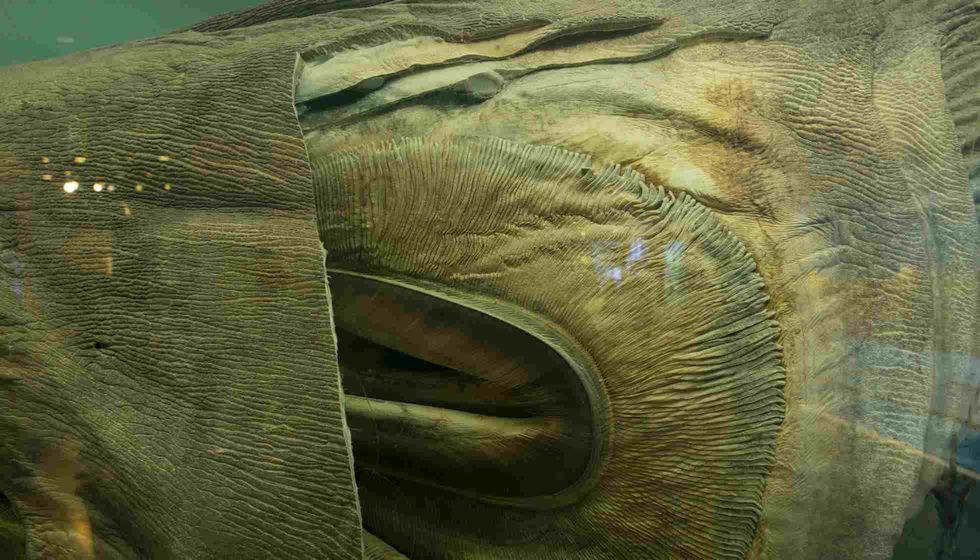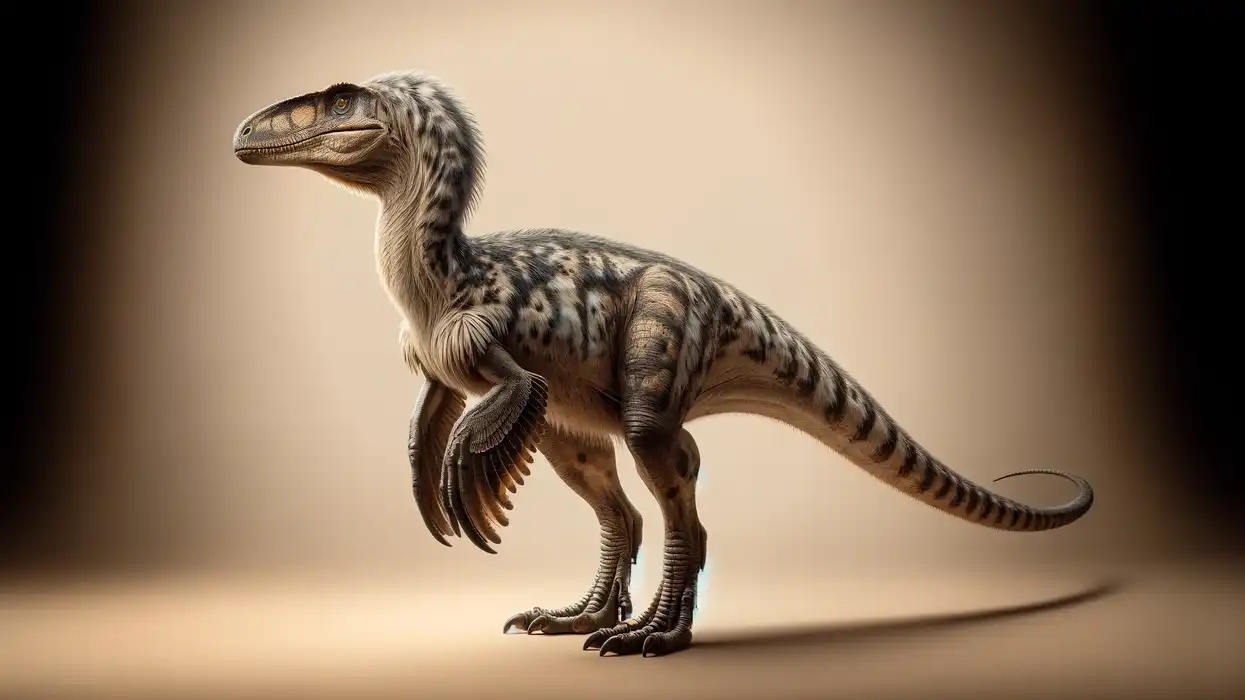The megamouth shark (Megachasma pelagios) is a type of shark that lives in the deep sea. They belong to the family Megachasmidae.
These sharks were discovered in 1976 when one of them got tangled by chance in the sea anchor of United States Navy ship AFB-14, near the coast of Oahu, Hawaii. It was captured from a depth of 541 ft (165 m) under the sea.
This particular specimen was about 14.7 ft (4.5 m) long and weighed around 1,650 lb (750 kg).
This discovery of a new species of shark became a great epoch of the past century in ichthyology. Despite being one of the largest sharks, they are the smallest among the three filter-feeding sharks.
The other two extant species are the whale shark and the basking shark. Megamouths are found in the Indian, Atlantic, and Pacific Oceans inhabiting waters from near the surface to a depth of up to 15,000 ft (4.6 km).
This species is very rare and therefore biological specifications and other facts about them are limited. They migrate vertically during predation. They come close to the surface during nighttime and go back to the deep in the daytime. Their way of feeding is unique and is known as engulfment feeding. These enormous sharks look terrifying but are harmless.
To know more about these fascinating animals, read on as we have gathered a set of interesting facts about them for you to read. You can also read up more articles on loach and Atlantic cod.
Megamouth Shark Interesting Facts
What type of animal is a megamouth shark?
Megamouth sharks are a type of cartilaginous fish.
What class of animal does a megamouth shark belong to?
Megamouth sharks belong to the class Chondrichthyes.
How many megamouth sharks are there in the world?
According to records (until 2018), only 99 megamouth specimens had been spotted. Their exact population number is not known.
Where does a megamouth shark live?
They are found in the deep waters. They live in ocean depths ranging from near the surface to 15,000 ft (4.6 km) underwater.
This variation occurs due to crepuscular vertical migration. Their population is distributed across the Indian, Atlantic, and Pacific Oceans. These specimens have also been sighted in waters near and around Japan, the Philippines, Taiwan, Australia, California, Hawaii, Indonesia, and South Africa.
What is a megamouth shark's habitat?
They are fit for both epipelagic and mesopelagic habitats in tropical and temperate latitudes. They can be found in coastal as well as open ocean habitats.
Who do megamouth sharks live with?
Little is known about this species of shark. It is not known whether they are solitary or not. These diurnal fish vertically migrate to the surface at night and go back to the deep sea during the daytime as they feed on different prey that possibly follows this daily migratory pattern.
How long does a megamouth shark live?
The lifespan of megamouth sharks hasn't been found out yet. Nevertheless, it is believed that the age of an individual can be estimated from the number of growth rings on their vertebrae.
How do they reproduce?
Megamouth sharks are ovoviviparous. The eggs are internally fertilized and incubated and the female gives birth to fully developed megamouth shark babies.
These sharks lack a placenta that connects the mother to the young ones. During the gestation period, the developing embryo gets nourishment from yolk sacs and unfertilized eggs. The new ones become filter-feeding sharks soon after they are born.
What is their conservation status?
According to the IUCN, International Union for Conservation of Nature, the megamouth shark comes under Least Concern status with an unknown population trend. There have not been enough sightings to determine whether they are under threat or not.
Megamouth Shark Fun Facts
What does megamouth shark look like?

Megamouth sharks have a flabby body with dark blue, brownish-black, or gray color on the top surface and lighter color on the bottom. Their bulbous head consists of a wide, large mouth with small, slender teeth that curve inwards and a broad snout.
Their upper jaw has around 50 rows of teeth whereas the lower jaw has 75. There is a silvery-white band along the upper jaw.
This band is supposed to be a feeding mechanism that might help attract potential prey. Their dorsal fins are small, with the second dorsal fin being less than half the size of the first dorsal fin. Their tail is heterocercal, that is, it has asymmetrical upper and lower lobes.
The upper lobe is significantly larger. The insides of the gill slits are lined with gill rakers.
How cute are they?
These giant sharks are nothing like their looks. They are gentle beings. When it comes to a megamouth shark, size and features make it look fiery and dangerous even though it is not so.
How do they communicate?
Owing to their rare sightings, not enough knowledge is available about them. But it is believed that the white band in the upper jaw might possibly act as some means of identification or communication.
How big is a megamouth shark?
An average megamouth shark weighs 1,760 lb (800 kg). They can be as heavy as 2,700 lb (1,215 kg). They are around 13-18 ft (4-5.5 m) in length.
Males mature as they grow up to a length of 13 ft (4 m) while females mature as they grow up to a length of 16 ft (5 m). Even though they are huge, this deep water shark is the smallest among the three species of filter-feeding sharks. They are half the size of a basking shark.
How fast can a megamouth shark swim?
The megamouth shark swims at a speed ranging from 0.9-1.3 mph, which is very slow, keeping in mind its size. These sharks are relatively inactive, which is what also makes them slow swimmers.
How much does a megamouth Shark weigh?
They have an average weight of around 1,760 lb (800 kg). They can reach around 2,700 lb (1,215 kg).
What are their male and female names of the species?
There are no distinct names for males and females. A shark of this species, whether male or female, is commonly known as a megamouth shark or a bigmouth shark (Megachasma pelagios).
What would you call a baby megamouth shark?
The young ones can be called megamouth shark pups or babies.
What do they eat?
These sharks have a unique feeding mechanism and are filter-feeders, that is they feed themselves by filtration of plankton or tiny crustaceans. The megamouth shark diet includes plankton, shrimp, krill, jellyfish, and copepods.
Are they dangerous?
In contrast to their giant body and scary teeth, they are considered gentle in terms of behavior. No attacks have been recorded on humans so far.
Would they make a good pet?
No, they are not meant to be kept as pets. This is an aquatic species that is found in the deep sea.
Did you know...
The megamouth shark is naturally rare, but not extinct. A new species of megamouth shark that is extinct was discovered in 2013. This newly identified species existed about 23 million years ago.
The megamouth shark was first discovered near Hawaii on November 15, 1976, when it accidentally got entangled in the sea anchor of a US Navy ship.
These species are wide-mouth sharks. Their mouths measure 4 ft (1.3 m) wide.
Why is the megamouth shark so rare?
As they inhabit the ocean depths, sighting a megamouth shark is rare. As per records till March 2018, only 99 specimens had been either caught or sighted.
They are found to retreat to the ocean depths in response to small disturbances. This could be a possible reason why we haven't any found more of them. Some may think the megamouth shark is the rarest shark, but it is actually the pocket shark that is the rarest!
All about the megamouth shark's mouth
Megamouth sharks have large mouths that are wide enough to extend beyond their eyes. They have around 50-75 rows of teeth in their lower and upper jaws respectively, of which they use only three rows.
In females, the first five lower teeth are larger than the upper teeth. The megamouth shark teeth curve inwards and are small and slender.
The upper lip consists of a white band that is visible when the mouth is open. This is believed to be either an aid to attract prey or as a means of communicating between the species.
These bands were believed to contain luminous photophores and exhibit bioluminescence. Another claim proposes that the lower lip glows and the white band acts as a reflector.
Both theories haven't been proven yet. A recent study conducted in 2020 found that this species was not bioluminescent but that the white band reflects light.
The shark moves slowly with its mouth open through a group of prey, sucks them in, and occasionally closes it to decrease the pharyngeal volume which forces the water to flow out, concentrating the food on the gill rakers before swallowing. This is a unique mechanism known as engulfment feeding.
Here at Kidadl, we have carefully created lots of interesting family-friendly animal facts for everyone to discover! Learn more about some other fish including black dragonfish, or barramundi.
You can even occupy yourself at home by drawing one on our Megamouth shark coloring pages.










